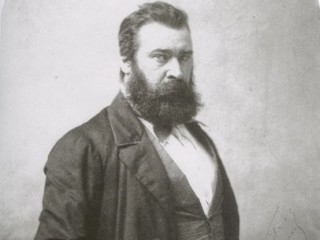
Jean Francois Millet biography
Date of birth : 1814-10-04
Date of death : 1875-01-20
Birthplace : Gruchy, Gréville-Hague, Normandy
Nationality : French
Category : Arts and Entertainment
Last modified : 2011-07-21
Credited as : Artist painter, ,
Jean François Millet was born in Gruchy near Greville on Oct. 4, 1814. His parents were peasants, and he grew up working on a farm. In 1837 Millet moved to Paris to study painting. To learn the traditions of classical and religious painting, he entered the studio of Paul Delaroche, a successful academic imitator of the revolutionary romanticist Eugene Delacroix. But Delaroche severely criticized the unsophisticated Millet, and the young artist's official schooling soon ended. He nevertheless stayed on in Paris, supporting himself by making pastel reproductions of rococo masters, occasional oil portraits, and commercial signs.
In 1841 Millet married Pauline Ono, who died in 1844. In 1845 the artist married Catherine Lemaire. During these years Millet continued to develop his painting, and like nearly all of his contemporaries, he sought recognition in the annual Parisian Salons. One of his portraits was accepted by the Salon of 1840; two pictures were included in the Salon of 1844; and he received special praise for the Winnower in the Salon of 1848. An 1845 exhibition at Le Havre was also moderately successful for the artist.
During the 1840s Millet's painting gradually shifted from classical and religious subjects to scenes of the rural and peasant life with which he was familiar. As it did, he gained increasing support and recognition from other painters in his generation. Among these were Narcisse Diaz de la Peña and Theodore Rousseau, two landscape painters who were instrumental in forming the loose association of artists known as the Barbizon school. Millet and the other Barbizon artists resisted the grand traditions of classical and religious painting, preferring a direct, unaffected confrontation with the phenomena of the natural world. During the 1830s and 1840s their works were generally regarded as crude, unfinished, and unacceptable to the official tastes of the Parisian Salons. After mid-century, however, the Barbizon artists slowly gained increasing recognition, and their achievement became an important inspiration for the younger generation of impressionists.
Millet moved to Barbizon in 1848. The picturesque village became his home for the rest of his life, and he died there on Jan. 20, 1875. During that period he produced his most mature and celebrated paintings, including the Gleaners (1857), the Angelus (1857-1859), the Sower (1850), and the Bleaching Tub (ca. 1861). The works are characterized by breadth and simplicity; they generally depict one or two peasant figures quietly engaged in earthy or domestic toil. With sweeping, generalized brushwork and a monumental sense of scale, Millet consistently dignified his characters and transformed them into heroic pictorial beings.


















